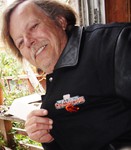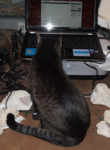
WHY DO WE SELL FOSSILS?
The concept of Hunton Fossils is to make available to the public specimens derived from surface collections made at the Old Hunton town site locality. The outcrop exists in its’ native state so as to preserve it for future generations and hopefully, future paleontological study. Our purchase of this locality was due to events well beyond coincidence, and it is my hope that with time this locality will be appreciated for what it has always been – a national treasure remaining in obscurity. Few collecting localities can compete with the natural beauty, although rugged, which sets this region apart from what fossil collectors are used to.
I was not born in Oklahoma, but I lived there from 1982 thru 1985 while working in the oil industry. The Old Hunton town site locality was the first fossil locality that I visited upon arriving in the state. Campbell’s (1977) publication on Devonian trilobites of Oklahoma through the Oklahoma Geological Survey had only recently been released at that time. It was obvious in viewing the photos of the specimens that the majority of them had been found at either White Mound or the Old Hunton town site. I suppose it was the photos of Reedops deckeri that induced me to investigate the Old Hunton town site first.
On that initial visit, I met Larry Patton, and then was directed to drive out to meet his dad, Jack Patton, owner of the property. Jack invited me into his house, and after some pleasant discussion, allowed me to collect fossils there. I returned many times thereafter over the course of four years, often accompanied by others who were also granted access. It was during this time that I grew to appreciate this locality as being relatively obscure, considering its’ dimensions, and somewhat vastly underappreciated, because it contained a variety of fossils with pristine preservation contained within rock layers which seemed to go on forever. In fact, this locality merges with Black Cat Mountain over a course of a couple of miles evidenced by limited southern exposures of low lying strata that traverse the distance between the two.
For a prolonged period of time, this locality was closed to the public due to commercial concerns after leasing of adjacent exposures for mining began. Rather than welcome the new found prosperity that digging would develop, the Patton family chose to leave this area undeveloped and perhaps forgotten.
My recollection of the days I’d spent there induced me to stop by in 2003 while travelling through Oklahoma after a long absence from this state. Considering the timing of this visit, the circumstances that produced it, and the manner in which I was greeted (as this locality was still restricted with regard to fossil collecting, and no one had been allowed access, but for me, they were allowing access), I could not help feeling overwhelmed by a sense that this visit was no accident. It was to become my dream of preserving science and nature together at a place I love for as long as humanly possible.
The sign on the gate read "Heaven" and nearby was posted a Goodson Realty sign. After speaking with Larry Patton at his house, I was given access to collect fossils there. Then I met with his brother-in-law while on the outcrop, and that is when it occurred to me that God wanted me to buy this place. He was handling the sale of the land, and made mention that I was the first person that they had let on the property to collect fossils. The purchase price I considered low by California standards, and with the help of my family, we bought this land. The majority of the Old Hunton town site studied by past paleontologists exists here.
While living in Oklahoma, I obtained research volumes listing many localities, and it became my passion to visit those localities that were listed as containing trilobites, echinoderms, brachiopods, and other marine invertebrates, as well as to learn about the formational characteristics related to the depositional environments of the many different rock units. Several of those sites are very interesting, scenic, and productive. But there was always something about the scenery here that made me feel as if I were at home. It resembles the feeling of childhood for me, from a nexus perspective. It also allows me to forgo delving into its’ secrets with a backhoe. I find that I am still able to achieve an active and scientific perspective, along with a great deal of enjoyment, from surface collecting and/or surface mining. During these incursions, we find the specimens that are being offered here for sale. Although rare and unusual pieces will normally not be sold, enough material is found at the outcrop to ensure a variety of specimens to choose from that are unique in origin and suitable for scientific study.
After moving to California in 1985, I started a career in surveying after deciding to forgo a career as a geologist. My education in geology commenced with a Bachelor’s degree from the University of Cincinnati, followed by a Master’s degree in Paleoecology at Miami University of Oxford, Ohio. The highlights of the undergraduate education were the courses taken under the esteemed Dr. Ken Caster (Historical Geology, Advanced Historical Geology, and Plate Tectonics) along with courses taken under the then soon to be acknowledged crinoid specialist Dr. David L. Meyer (Paleontology, Advanced Paleontology, Paleoecology, and independent study). While at Miami, I met colleagues who would become friends and fellow collectors, even thru the early days in Oklahoma. As with all friends, we built off those relationships, and that enabled us to learn a great deal more about the geology that we were interested in. One of these associates owns a Bed and Breakfast retreat in Wyoming located upon the famous Cretaceous Hell Creek formation.
The web address is
wyomingdinosaurs.com
After leaving Oklahoma, and the profession of geology, I settled into the life of a surveyor working within the San Francisco Bay area. It has become a life that I am well suited for; the majority of my career has involved field surveying for the State of California's Department of Transportation (Caltrans). Despite being away from so many familiar Paleozoic rocks out here, I managed to gain a working interest again in paleontology through trips to the Stanford Geology Library, where I began to research the Paleozoic rocks of Nevada. Although the field work has been limited, I have continued to investigate strata that I presume to be productive for fossils within that state which span the Ordovician through Devonian periods. The associations of the preserved organisms within the fossil assemblages constitute data sets for studying relationships concerning paleoecology and regional correlation. It has become easier now to study about these relationships through the various scientific publications that are accessible over the Internet.
In 2015 I retired from land surveyng and I began working with fossils on a more regular basis. The fossils that I usually work with since then are from the Old Hunton town site and neighboring Black Cat Mountain. On occasion I have spent time in transit at the Ike's Canyon locality within the Toquima Range of Nevada. Lately I have been working with that collection also. I will include a section on that fauna on this site when I am able. The fossils occur within a lower Middle Ordovician setting around a sponge reef development along the shelf margin as it existed in Nevada at that time when the beginning of the Global Ordovician Biodiversification Event was taking place.
When studying the Paleozoic history of Nevada, the immensity of surface geology available for study is somewhat overwhelming. The difficulty in getting from here to there makes investigation difficult. I am sure that that will be the case with additional frontiers within North America. While Oklahoma paleozoics are hidden within private property locations that impede their study, the strata in Nevada are open for all to examine. It is the trek to each locality that preserves their secrets.
I have come to view paleontology as a science that one could enjoy for many lifetimes if you only had the chance. It might take that long just to explore one of the western states. However, never to be forgotten is the natural enjoyment of finding a great fossil and then in the cleaning of the fossil specimens afterwards, if only for the appreciation of their intrinsic beauty that has held up for such a long time. It has been written "I’d rather be fishing than working" and such is the life of the fossil hunter. It is my privilege to preserve the fossils I find from the Old Hunton town site and neighboring Black Cat Mountain in order to inspire your interest, study, amusement, or otherwise. While children may become passionately interested in fossils once they are exposed to them in this way, any person can develop an insatiable curiosity regarding these invertebrate fossils once they have been exposed to them. With supervision, younger students and older fossils like me can enjoy fossils and come to respect them as artifacts and not toys, although sometimes even I think they remind me of Pokémon.
California Dave



